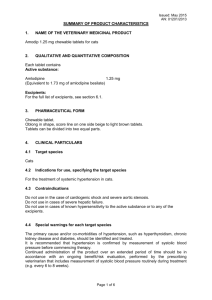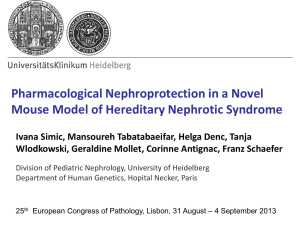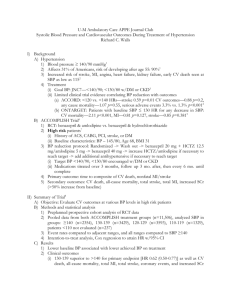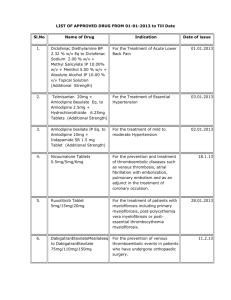Amlo
advertisement
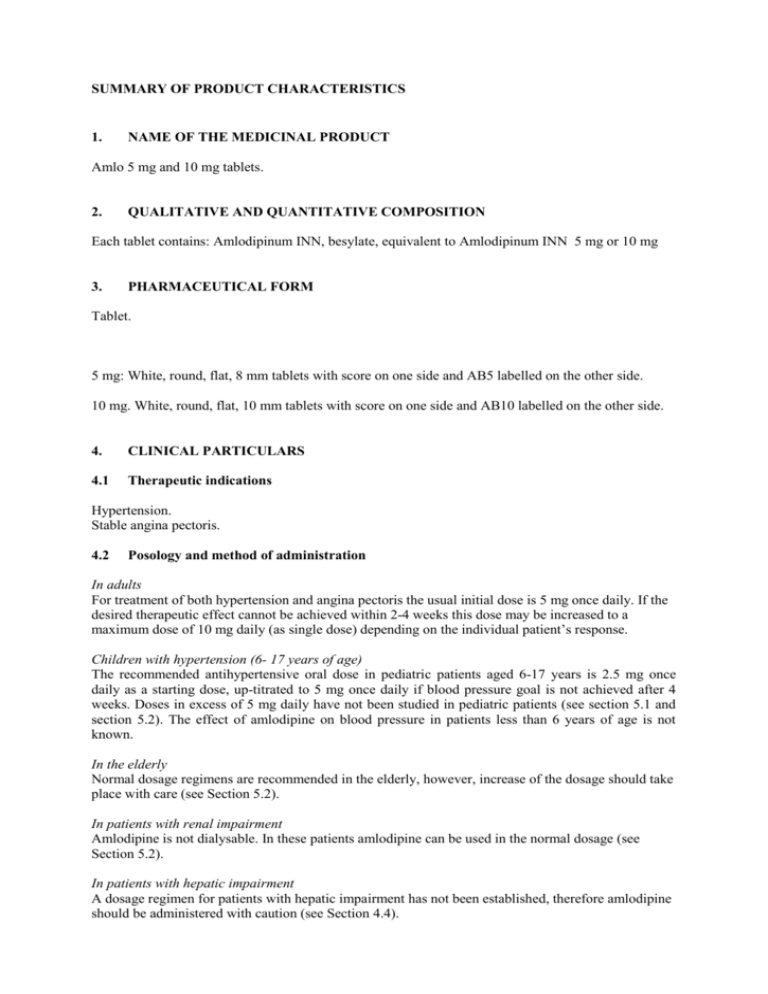
SUMMARY OF PRODUCT CHARACTERISTICS 1. NAME OF THE MEDICINAL PRODUCT Amlo 5 mg and 10 mg tablets. 2. QUALITATIVE AND QUANTITATIVE COMPOSITION Each tablet contains: Amlodipinum INN, besylate, equivalent to Amlodipinum INN 5 mg or 10 mg 3. PHARMACEUTICAL FORM Tablet. 5 mg: White, round, flat, 8 mm tablets with score on one side and AB5 labelled on the other side. 10 mg. White, round, flat, 10 mm tablets with score on one side and AB10 labelled on the other side. 4. CLINICAL PARTICULARS 4.1 Therapeutic indications Hypertension. Stable angina pectoris. 4.2 Posology and method of administration In adults For treatment of both hypertension and angina pectoris the usual initial dose is 5 mg once daily. If the desired therapeutic effect cannot be achieved within 2-4 weeks this dose may be increased to a maximum dose of 10 mg daily (as single dose) depending on the individual patient’s response. Children with hypertension (6- 17 years of age) The recommended antihypertensive oral dose in pediatric patients aged 6-17 years is 2.5 mg once daily as a starting dose, up-titrated to 5 mg once daily if blood pressure goal is not achieved after 4 weeks. Doses in excess of 5 mg daily have not been studied in pediatric patients (see section 5.1 and section 5.2). The effect of amlodipine on blood pressure in patients less than 6 years of age is not known. In the elderly Normal dosage regimens are recommended in the elderly, however, increase of the dosage should take place with care (see Section 5.2). In patients with renal impairment Amlodipine is not dialysable. In these patients amlodipine can be used in the normal dosage (see Section 5.2). In patients with hepatic impairment A dosage regimen for patients with hepatic impairment has not been established, therefore amlodipine should be administered with caution (see Section 4.4). The tablets should be taken with a glass of water independently from meals. 4.3 Contraindications Amlodipine is contraindicated in patients with: - hypersensitivity to dihydropyridine derivatives, amlodipine or any of the excipients severe hypotension shock, including cardiogenic shock obstruction of the outflow tract of the left ventricle (e.g. high grade aortic stenosis) haemodynamically unstable heart failure after acute myocardial infarction 4.4 Special warnings and precautions for use The safety and efficacy of amlodipine in hypertensive crisis has not been established. Patients with cardiac failure: Patients with heart failure should be treated with caution. In a long-term, placebo controlled study in patients with severe heart failure (NYHA class III and IV) the reported incidence of pulmonary oedema was higher in the amlodipine treated group than in the placebo group, but this was not associated with worsening of the heart failure (see section 5.1). Use in patients with impaired hepatic function: The half life of amlodipine is prolonged in patients with impaired liver function; dosage recommendations have not been established. Amlodipine should therefore be administered with caution in these patients. Use in elderly patients In the elderly increase of the dosage should take place with care (see section 5.2). Use in renal failure Amlodipine may be used in such patients at normal doses. Changes in amlodipine plasma concentrations are not correlated with degree of renal impairment. Amlodipine is not dialyzable. 4.5 Interaction with other medicinal products and other forms of interaction Effects of other medicinal products on amlodipine CYP3A4 inhibitors: With concomitant use with the CYP3A4 inhibitor erythromycin in young patients and diltiazem in elderly patients respectively the plasma concentration of amlodipine increased by 22% and 50 % respectively. However, the clinical relevance of this finding is uncertain. It cannot be ruled out that strong inhibitors of CYP3A4 (i.e. ketoconazole, itraconazole, ritonavir) may increase the plasma concentrations of amlodipine to a greater extent than diltiazem. Amlodipine should be used with caution together with CYP3A4 inhibitors. However, no adverse events attributable to such interaction have been reported. CYP3A4 inducers: There is no data available regarding the effect of CYP3A4 inducers on amlodipine. The concomitant use of CYP3A4 inducers (i.e. rifampicin, hypericum perforatum) may give a lower plasma concentration of amlodipine. Amlodipine should be used with caution together with CYP3A4 inducers. In clinical interaction studies grapefruit juice, cimetidine, aluminium/ magnesium (antacid) and sildenafil did not affect the pharmacokinetics of amlodipine. Effects of amlodipine on other medicinal products The blood pressure lowering effects of amlodipine adds to the blood pressure-lowering effects of other antihypertensive agents. In clinical interaction studies, amlodipine did not affect the pharmacokinetics of atorvastatin, digoxin, ethanol (alcohol), warfarin or cyclosporin. There is no effect of amlodipine on laboratory parameters. 4.6 Pregnancy and lactation Pregnancy The safety of amlodipine in human pregnancy has not been established. Reproductive studies in rats have shown no toxicity except for delayed date of delivery and prolonged duration of labour at dosages 50 times greater than the maximum recommended dosage for humans. Use in pregnancy is only recommended when there is no safer alternative and when the disease itself carries greater risk for the mother and foetus. Lactation It is not known whether amlodipine is excreted in breast milk. A decision on whether to continue/discontinue breast-feeding or to continue/discontinue therapy with amlodipine should be made taking into account the benefit of breast-feeding to the child and the benefit of amlodipine therapy to the mother. 4.7 Effects on ability to drive and use machines Amlodipine can have minor or moderate influence on the ability to drive and use machines. If patients taking amlodipine suffer from dizziness, headache, fatigue or nausea the ability to react may be impaired. 4.8 Undesirable effects The following undesirable effects have been observed and reported during treatment with amlodipine with the following frequencies: Very common (≥1/10); common (≥1/100 to <1/10); uncommon (≥1/1,000 to ≤1/100); rare (≥1/10,000 to ≤1/1,000); very rare (≤1/10,000). System Organ Class Blood and the lymphatic system disorders Immune system disorders Metabolism and nutrition disorders Psychiatric disorders Nervous system disorders Frequency Very Rare Undesirable effects Leukocytopenia, thrombocytopenia Very Rare Very Rare Allergic reactions Hyperglycaemia Uncommon Insomnia, mood changes (including anxiety), depression Confusion Somnolence, dizziness, headache (especially at the beginning of the treatment) Tremor, dysgeusia, syncope, hypoesthesia, paresthesia Hypertonia, peripheral neuropathy Visual disturbance (including diplopia) Tinnitus Rare Common Uncommon Very Rare Eye disorders Ear and labyrinth disorders Uncommon Uncommon Cardiac disorders Vascular disorders Respiratory, thoracic and mediastinal disorders Gastrointestinal disorders Uncommon Palpitations Very Rare Myocardial infarction, arrhythmia (including bradycardia, ventricular tachycardia and atrial fibrillation) Flushing Hypotension Vasculitis Dyspnoea, rhinitis Cough Abdominal pain, nausea Vomiting, dyspepsia, altered bowel habits (including diarroheoa and constipation), dry mouth Pancreatitis, gastritis, gingival hypeplasia Hepatitis, jaundice, hepatic enzymes increased* Alopecia, purpura, skin discolouration, hyperhydrosis, pruritus, rash, exanthema Angioedema, erythema multiforme, urticaria, exfoliative dermatitis, StevensJohnson syndrome, Quincke oedema Photosensitivity Ankle swelling Common Uncommon Very Rare Uncommon Very Rare Common Uncommon Very Rare Hepato-biliary disorders Very Rare Skin and subcutaneous tissue disorders Uncommon Very Rare Musculoskeletal, connective tissue and bone disorders Very rare Common Uncommon Renal and urinary disorders Uncommon Reproductive system and breast disorders General disorders and administration site conditions Uncommon Arthralgia, myalgia, muscle cramps, back pain Micturition disorder, nocturia, increased urinary frequency Impotence, gynecomastia Common Oedema, fatigue Uncommon Chest pain, asthenia, pain, malaise Uncommon Investigations *mostly consistent with cholestasis 4.9 Weight increase, weight decrease Overdose In humans experience with intentional overdose is limited Symptoms: Available data suggest that gross overdosage could result in excessive peripheral vasodilatation and possibly reflex tachycardia. Marked and probably prolonged systemic hypotension up to and including shock with fatal outcome have been reported. Treatment: Clinically significant hypotension due to amlodipine overdosage calls for active cardiovascular support including frequent monitoring of cardiac and respiratory function, elevation of extremities and attention to circulating fluid volume and urine output. A vasoconstrictor may be helpful in restoring vascular tone and blood pressure, provided that there is no contraindication to its use. Intravenous calcium gluconate may be beneficial in reversing the effects of calcium channel blockade. Gastric lavage may be worthwhile in some cases. In healthy volunteers the use of charcoal up to 2 hours after administration of amlodipine 10 mg has been shown to reduce the absorption rate of amlodipine. Since amlodipine is highly protein-bound, dialysis is not likely to be of benefit. 5. PHARMACOLOGICAL PROPERTIES 5.1 Pharmacodynamic properties Selective calcium-channel blockers with mainly vascular effects. Dihydropyridine derivatives ATC code: C08CA01 Amlodipine is a calcium antagonist and inhibits the influx of calcium ions into cardiac and vascular smooth muscle. The mechanism of the antihypertensive action is due to a direct relaxant effect on vascular smooth muscle. The precise mechanism by which amlodipine relieves angina has not been fully determined but the following two actions play a role: 1. Amlodipine dilates peripheral arterioles and thus, reduces the total peripheral resistance (afterload) against which the heart works. This unloading of the heart reduces myocardial energy consumption and oxygen requirements. 2. The mechanism of action also probably involves dilatation of the main coronary arteries and coronary arterioles. This dilation increases the supply in oxygen to myocardiac muscle in patients with Prinzmetal anginal attack. In patients with hypertension, once daily dosing provides clinically significant reductions of blood pressure (in both supine and standing positions) throughout the 24 hour interval. In patients with angina, once daily administration of amlodipine increases total exercise time, the delay of occurrence of anginal attack and the delay of the occurrence of a 1-mm ST interval. Amlodipine decreases both angina attack frequency and glyceryl trinitrate tablet consumption. Use in Patients with Heart Failure Haemodynamic studies and exercise based controlled clinical trials in NYHA Class II-IV heart failure patients have shown that amlodipine did not lead to clinical deterioration as measured by exercise tolerance, left ventricular ejection fraction and clinical symptomatology. A placebo controlled study (PRAISE) designed to evaluate patients in NYHA Class III-IV heart failure receiving digoxin, diuretics and angiotensin-converting enzyme (ACE) inhibitors has shown that amlodipine did not lead to an increase in risk of mortality or combined mortality and morbidity in patients with heart failure. In a follow-up, long-term, placebo controlled study (PRAISE-2) of amlodipine in patients with NYHA III and IV heart failure without clinical symptoms or objective findings suggestive of underlying ischaemic disease, on stable doses of ACE inhibitors, digitalis, and diuretics, amlodipine had no effect on total or cardiovascular mortality. In this same population amlodipine was associated with increased reports of pulmonary oedema despite no significant difference in the incidence of worsening heart failure as compared to placebo. In a study involving 268 children aged 6-17 years with predominantly secondary hypertension, comparison of a 2.5mg dose, and 5.0mg dose of amlodipine with placebo, showed that both doses reduced Systolic Blood Pressure significantly more than placebo. The difference between the two doses was not statistically significant. The long-term effects of amlodipine on growth, puberty and general development have not been studied. The long-term efficacy of amlodipine on therapy in childhood to reduce cardiovascular morbidity and mortality in adulthood have also not been established. 5.2 Pharmacokinetic properties Absorption/Distribution After oral administration of therapeutic doses, amlodipine is slowly absorbed. Absorption of amlodipine is not influenced by concomitant food intake. Absolute bioavailability of the unchanged active substance is estimated to be 64-80%. Peak plasma levels are reached 6-12 hours after administration. The volume of distribution is approximately 21 l/kg. The pKa of amlodipine is 8.6. In vitro studies have shown that amlodipine is bound to plasmatic proteins up to 97.5%. Metabolism/Elimination The plasma elimination half-life is about 35-50 hours. Steady-state plasma levels are reached after 7-8 consecutive days. Amlodipine is extensively metabolised to inactive metabolites. About 60% of the administered dose is excreted in the urine, of which 10% is as unchanged amlodipine. Use in Elderly The time to reach peak plasma concentrations of amlodipine is similar in elderly and younger subjects. Amlodipine clearance tends to be decreased with resulting increases in AUC and elimination half life in elderly patients. Increases in AUC and elimination half life in patients with congestive heart failure were as expected for the patient age group study (See Section 4.4). In patients with renal failure Amlodipine is extensively metabolised to inactive metabolites. 10% of the parent compound is excreted unchanged in urine. Changes in amlodipine concentration are not correlated with degree of renal impairment. Therefore the normal dosage is recommended. Amlodipine is not dialysable. Patients with hepatic impairment: The half-life of amlodipine is prolonged in patients with impaired hepatic function. A population PK study has been conducted in 74 hypertensive children aged from 12 month to 17 years (with 34 patients aged 6 to 12 years and 28 patients aged 13 to 17 years) receiving amlodipine between 1.25 and 20 mg given either once or twice daily. In children 6 to 12 years and in adolescents 13-17 years of age the typical oral clearance (CL/F) was 22.5 and 27.4 L/hr respectively in males and 16.4 and 21.3 L/hr respectively in females. Large variability in exposure between individuals was observed. Data reported in children below 6 years is limited. 5.3 Preclinical safety data Preclinical data reveal no special hazard for humans based on conventional studies of safety pharmacology, repeated dose toxicity, genotoxicity and carcinogenic potential. In animal studies with respect to reproduction in rats at high doses delayed parturition, difficult labour and impaired foetal and pup survival were seen. 6. PHARMACEUTICAL PARTICULARS 6.1 List of excipients The following exipients where used in the manufacturing of Amlo: Microcrystalline cellulose, calcium hydrogen phosphate dihydrate, sodium starch glycolate and magnesium stearate. 6.2 Incompatibilities Not applicable. 6.3 Shelf life 2 years 6.4 Special precautions for storage Store at room temperature (15-25C) in closed containers. 6.5 Nature and contents of container Plastic tablet containers. Pack sizes, plastic tablet containers: Amlo 5 mg: 30 and 100 tablets. Amlo 10 mg: 30 and 100 tablets. Not all pack sizes may be marketed. 6.6 Special precautions for disposal No special requirements. 7. MARKETING AUTHORISATION HOLDER Actavis hf Reykjavikurvegi 76-78, 220 Hafnarfjordur, Iceland 8. MARKETING AUTHORISATION NUMBER Amlo 5 mg: Amlo 10 mg: 9. MA155/00202 MA155/00201 DATE OF FIRST AUTHORISATION/RENEWAL OF AUTHORISATION 15th November 2006 10. DATE OF REVISION OF THE TEXT 27th August 2011
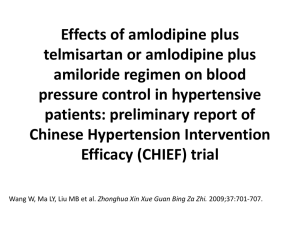
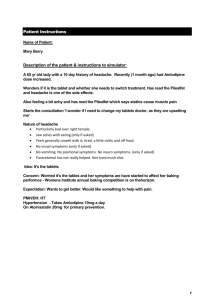
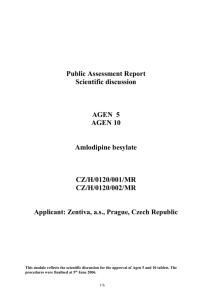

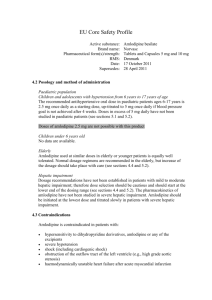
![njc6_publication_2[^]](http://s3.studylib.net/store/data/007850226_2-d94f2aa4ee57f77430443fae8e981d05-300x300.png)
